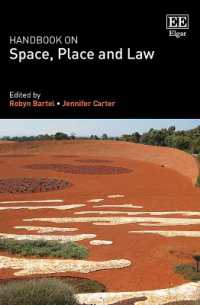- ホーム
- > 洋書
- > 英文書
- > Science / Mathematics
基本説明
Primarily aimed at postgraduate and advanced undergraduate students.
Full Description
The work of conservation biology has grown from local studies of single species into a discipline concerned with mapping and managing biodiversity on a global scale. Remote sensing, using satellite and aerial imaging to measure and map the environment, increasingly provides a vital tool for effective collection of the information needed to research and set policy for conservation priorities. The perceived complexities of remotely sensed data and analyses have tended to discourage scientists and managers from using this valuable resource. This text focuses on making remote sensing tools accessible to a larger audience of non-specialists, highlighting strengths and limitations while emphasizing the ways that remotely sensed data can be captured and used, especially for evaluating human impacts on ecological systems.
Contents
Preface ; Acronyms List ; 1. Introduction: Why Ecologists and Conservation Biologists Use Remote Sensing ; 2. When to Use Remote Sensing ; 3. Working with Images ; 4. Measuring and Monitoring Land Cover, Land Use, and Vegetation Characteristics ; 5. Terrain and Soils ; 6. Marine and Coastal Environments ; 7. Wetlands-Estuaries, Inland Wetlands, and Freshwater Lakes ; 8. Atmosphere and Climate ; 9. Disturbances: Fires and Floods ; 10. Landscape Fragmentation ; 11. Human Interfaces and Urban Change ; 12. Protected Area Design and Monitoring ; 13. Integrating Field Data ; 14. Linking Remote Sensing with Modeling ; 15. Global Conservation ; Appendix 1 The Electromagnetic Spectrum ; Appendix 2 Image Processing Software ; Appendix 3 Open Source Software ; Appendix 4 Satellites and Sensors ; Appendix 5 Visual Interpretation ; Appendix 6 Systems for Observing Climate and Atmospheric Phenomena ; References ; Index







